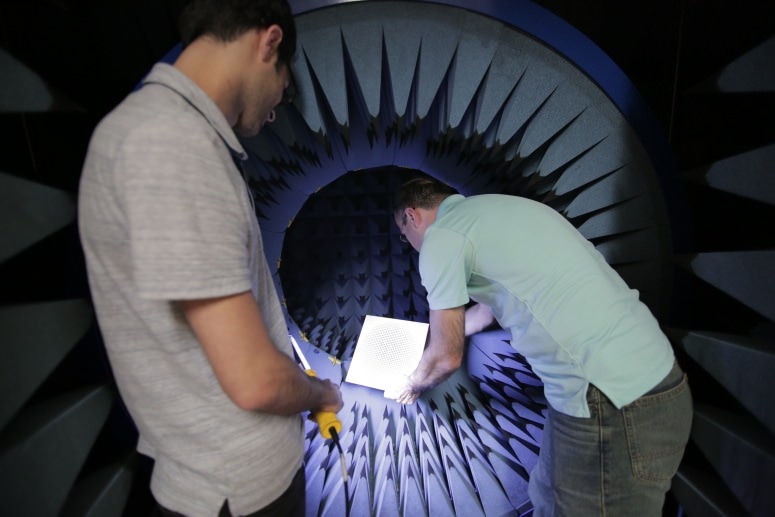Aug 31 2016
 Amin Momeni illuminates the antenna-testing chamber while Nader Behdad installs a phased-array antenna. The flat surface consists of multiple precisely-positioned elements that convert spherical radio signals into single-column beams. (Credit STEPHANIE PRECOURT)
Amin Momeni illuminates the antenna-testing chamber while Nader Behdad installs a phased-array antenna. The flat surface consists of multiple precisely-positioned elements that convert spherical radio signals into single-column beams. (Credit STEPHANIE PRECOURT)
Most antennas have to rotate, tracing circles, in the sky. The radar arrays fixed on top of air-traffic control towers sweep signals from all directions by rotating.
However, endlessly spinning large objects require lot of mechanical energy and time. Communication and detection at long ranges can be optimized if scanning can take place from a stationary position.
A new strategy to design such stationary antennas that can trace circles with their rotating beams without movement of the devices is being developed by electrical engineers at the University of Wisconsin–Madison, thanks to a U.S. Office of Naval Research grant of $1.1 million.
Our approach doesn’t depend on exotic materials that bend the laws of physics. We’ve found a practical way to achieve beam-steering that the antennas field has largely overlooked for many years.
Nader Behdad, Professor, UW–Madison
A method to reorient beams at rapid rates has been a longtime pursuit of engineers. However, advancements in the field have been slow and the technology available is too expensive to facilitate widespread use. Due to the life-and-death severity of scanning the sky, researchers have not given up their search.
In defense situations, you need to detect incoming objects or see where you are going very quickly. The ability of a mechanical rig to move a big, heavy parabolic dish back and forth limits how quickly you can respond to potential threats.
John Booske, Professor, UW–Madison
Flat planes made of mini-transmitters can be used to compensate for mechanical motion. Each of these transmitters can emit varied fractions of an overall signal that can then be summed to form a single linear beam. Known as phase-varied arrays, these antennas can change the electronic properties of each and every signal source to change the direction of the overall beam.
However, numerous small-scale antennas bundled up in one surface make colossal devices that are expensive and limited in their usefulness.
Instead of building a phased array, the researchers intend to develop special reflective surfaces that depend on a single signal source to deliver the same effect.
“Up until this idea there was practically no way to meet the almost impossible specification of the ideal solution,” says Booske.
The flat arrays alter the electronic properties of all the elements on their surfaces to direct the microwave signals into focused columns. This mechanism is similar to how the curved reflectors of a car’s headlamp focus the light emanated spherically from a single bulb into a forward beam. The flat arrays, unlike mirrored dishes, can tune the individual elements on their surface to change the direction of the reflected beams.
However, achieving this tuning is a difficult feat. Behdad experimented with various complex methods to adjust every component before Booske and he realized that the individual elements need not be controlled one by one.
By adjusting the ground plane, a large component that is fitted below the whole structure, the researchers generated small-scale mechanical motion inside the whole antenna.
Luckily for us, in order to do beam-steering, we really don’t need to individually tune each element. All we need to do is create a gradient and we can do that by simply tilting the ground plane on one corner a little bit down and the other a little bit up.
Nader Behdad, Professor, UW–Madison
Compared to rotating a large reflector dish, generating tiny tilting motions within a flat plane require considerably less mechanical energy and time. A low-cost prototype was created by the team to test the viability of this strategy. The prototype reaffirmed the concept to electromagnetic principles. The researchers are currently working to find appropriate techniques and materials for optimizing the concept and making it ready for use in real-life applications.
With help from the Wisconsin Alumni Research Foundation, the team has applied for a patent for their concept, and it remains to be granted.